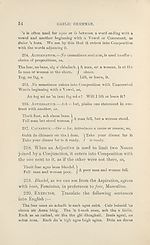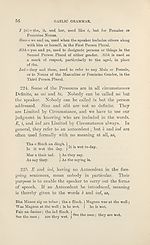Download files
Complete book:
Individual page:
Thumbnail gallery: Grid view | List view

THE FUNCTIONS OF WORDS.
55
agus fosgail uinneag. Tha mac agus nighean Iain anns an sgoil.
Gabhaidh Calum im no caise. Th&d Alasdair do ’n bhaile agus
fanaidh Cairistiona 6g aig an tigh. Tha mnathan ’us clann
bheag aig an t-sruth. Tha an t-each bin agus an lair dhonn
anns an achadh, ach tha na laoigh aig taobh an t-sruith. Ni
amadan tair air gliocas agus air teagasg. A mhic, eisd ri
teagasg t’ athar agus na diult comhairle do mhathar. Faigh an
sgian gu luath agus gearr an r6pa. Tha Iain aig an tigh, ach
tha Seumas aig a’ chladach leis an lair bhain. Pillidh freagradh
min corruich, ach diiisgidh briathran garga fearg. Bha ’n la
fuar, flinch, agus bha moran de dhaoine bochda mu ’n dorus.
Dion bhur diithaich ’us cliu bhur sinnsir.
221. Pronouns.—Pronouns, like Conjunctions, are
Labour-Saving Words, inasmuch as they save repeti¬
tion, and one was given as an example at U 208,
namely:—
Thuit clach agus bhris l.
Fell stone and broke it.
}
)
A stone fell and broke.
222. / is a Pronoun, and saves us from saying thuit
dach agus bhris a’ Mach. It points back like the Article
a’ in the last sentence, to some word which goes before
it. In this respect, there is an affinity between the
Pronoun and the Article. In general, pronouns are
words used in place of Antecedent Nouns, but not
always; they have other uses, as will be seen.
223. Personal Pronouns.—There are seven Pronouns
which correspond to i, called Personal Pronouns,
namely:—
3/4 = 1 and me, used by a speaker to designate himself, or the
First Person.
Tu (thu) = you, ye, thou and thee, used to designate the
person spoken to, or the Second Person.
E (si) = he, it, and him, used to refer to anything not of the
First or Second Person, i.e. of the Third Person, when it
is of the Male Sex, or is a Masculine Noun.
55
agus fosgail uinneag. Tha mac agus nighean Iain anns an sgoil.
Gabhaidh Calum im no caise. Th&d Alasdair do ’n bhaile agus
fanaidh Cairistiona 6g aig an tigh. Tha mnathan ’us clann
bheag aig an t-sruth. Tha an t-each bin agus an lair dhonn
anns an achadh, ach tha na laoigh aig taobh an t-sruith. Ni
amadan tair air gliocas agus air teagasg. A mhic, eisd ri
teagasg t’ athar agus na diult comhairle do mhathar. Faigh an
sgian gu luath agus gearr an r6pa. Tha Iain aig an tigh, ach
tha Seumas aig a’ chladach leis an lair bhain. Pillidh freagradh
min corruich, ach diiisgidh briathran garga fearg. Bha ’n la
fuar, flinch, agus bha moran de dhaoine bochda mu ’n dorus.
Dion bhur diithaich ’us cliu bhur sinnsir.
221. Pronouns.—Pronouns, like Conjunctions, are
Labour-Saving Words, inasmuch as they save repeti¬
tion, and one was given as an example at U 208,
namely:—
Thuit clach agus bhris l.
Fell stone and broke it.
}
)
A stone fell and broke.
222. / is a Pronoun, and saves us from saying thuit
dach agus bhris a’ Mach. It points back like the Article
a’ in the last sentence, to some word which goes before
it. In this respect, there is an affinity between the
Pronoun and the Article. In general, pronouns are
words used in place of Antecedent Nouns, but not
always; they have other uses, as will be seen.
223. Personal Pronouns.—There are seven Pronouns
which correspond to i, called Personal Pronouns,
namely:—
3/4 = 1 and me, used by a speaker to designate himself, or the
First Person.
Tu (thu) = you, ye, thou and thee, used to designate the
person spoken to, or the Second Person.
E (si) = he, it, and him, used to refer to anything not of the
First or Second Person, i.e. of the Third Person, when it
is of the Male Sex, or is a Masculine Noun.
Set display mode to:
![]() Universal Viewer |
Universal Viewer | ![]() Mirador |
Large image | Transcription
Mirador |
Large image | Transcription
| An Comunn Gàidhealach > An Comunn Gàidhealach Publications > Scottish Gaelic as a specific subject > (59) |
|---|
| Permanent URL | https://digital.nls.uk/125955725 |
|---|
| Description | This contains items published by An Comunn, which are not specifically Mòd-related. It includes journals, annual reports and corporate documents, policy statements, educational resources and published plays and literature. It is arranged alphabetically by title. |
|---|
| Description | A collection of over 400 items published by An Comunn Gàidhealach, the organisation which promotes Gaelic language and culture and organises the Royal National Mòd. Dating from 1891 up to the present day, the collection includes journals and newspapers, annual reports, educational materials, national Mòd programmes, published Mòd literature and music. |
|---|---|
| Additional NLS resources: |
|

